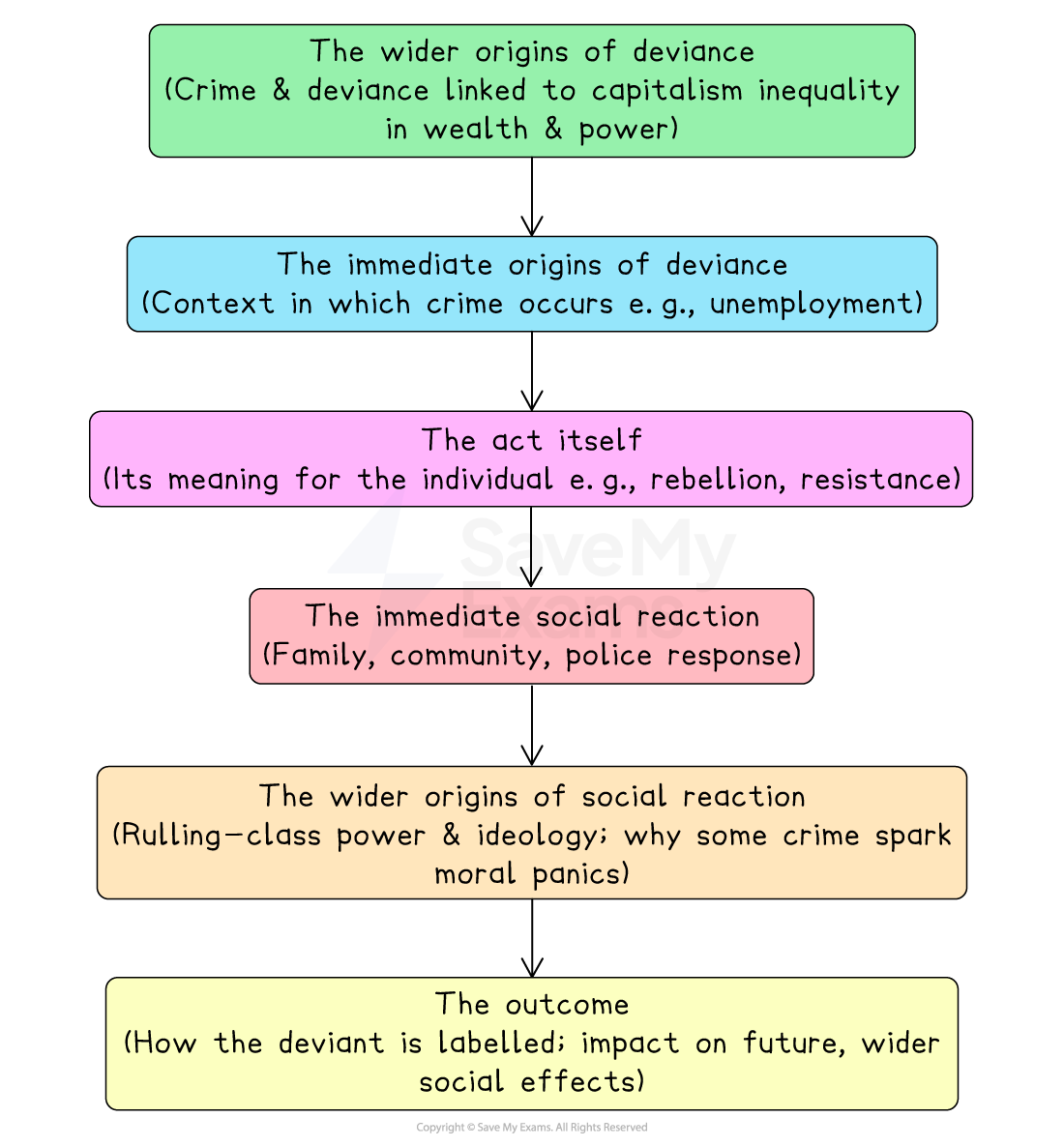The Neo-Marxist Perspective on Crime (AQA A Level Sociology): Revision Note
Exam code: 7192
Neo-Marxism & crime: critical criminology
Neo-Marxism combines Marxist ideas (crime linked to inequality and capitalism) with insights from labelling theory (crime as socially constructed)
Taylor, Walton and Young (1973) agree with Marxists that:
capitalism creates inequality and crime
the state makes and enforces laws in ruling-class interests
a classless society would greatly reduce crime
Anti-determinism
Neo-Marxists reject the determinism of traditional Marxism
Marxists often portray the working class as passive victims of capitalism, driven into crime by forces beyond their control
Instead, Neo-Marxists are interpretivists:
They see individuals as active agents with free will
Crime is a voluntaristic act — a conscious, meaningful choice
Criminals are not puppets of capitalism; they may be deliberately resisting or challenging the system
Crime as a political act
Taylor et al. argue that crime can be understood as a form of political protest against capitalism
Examples:
Burglary, robbery, and mugging are attempts to redistribute wealth from the rich to the poor
Vandalism is a symbolic attack on capitalism’s obsession with property
Drug use is due to a rejection of material values promoted by capitalism
Sabotage/rioting can be viewed as direct resistance to ruling-class power
The wider social meaning of crime must be considered, not just the act itself
The ruling class recognises this potential and uses the state apparatus (e.g., police) to control working-class resistance, often targeting poorer areas
The fully social theory of deviance
Taylor et al. (1973) outlined a 'fully social theory of deviance' – a comprehensive framework combining Marxist and interactionist ideas
They aimed to understand crime in a way that could help change society for the better
Six elements to understanding crime

This framework links micro-level meanings (individual motives) with macro-level structures (capitalism and power)
Evaluation of critical criminology
Strengths
Combines structure and agency
Links Marxist concern with inequality to labelling theory’s focus on social reaction
Provides a more complete framework for understanding crime
Crime as resistance
Highlights how crime can be a political act, challenging ruling-class power
Recognises the role of free will and choice, unlike traditional Marxism
Criticisms
Too idealistic
Left realists, e.g., Lea & Young argue Neo-Marxists romanticise criminals as political rebels
Most working-class crime is directed against other working-class people (e.g., burglary, assault), not the ruling class
Neglects victims
Ignores the real harm caused to victims of crime, especially in poor communities
Feminists criticise Taylor et al.'s approach for focusing mainly on male criminality, neglecting women
Over-complex
The 'fully social theory' is criticised as too abstract and difficult to apply in practice
Hopkins Burke (2005) argues that critical criminology is 'too idealistic' and offers little help in tackling crime
Examiner Tips and Tricks
To secure top AO2 marks in your essays, apply neo-Marxism’s critical criminology to real UK protest cases. This shows the examiner that you can link abstract ideas to the real world — a key skill in A-level Sociology.
Anti-determinism: The 'Blade Runners' (opens in a new tab) cutting down ULEZ cameras in London (2023–2025)
Neo-Marxism link: Instead of being passive victims of capitalism, these individuals made a voluntaristic choice to resist state economic policy. Their acts of criminal damage were a conscious protest against the rising costs of motoring, showing crime as an act of agency
Crime as a political act: Just Stop Oil (opens in a new tab) activists throwing soup at Van Gogh’s Sunflowers or spraying Stonehenge with orange powder (2024)
Neo-Marxism link: These actions can be seen as symbolic attacks on ruling-class values (heritage, property), reframing crime as political protest against fossil-fuel capitalism
The fully social theory of deviance: The Colston statue toppling (opens in a new tab)in Bristol (2020) — protestors pulled down the statue of a slave trader, sparking national debate.
Neo-Marxism link:
Wider origins: racism and inequality under capitalism
The act: symbolic resistance to ruling-class history
Reaction: moral panic in media; prosecutions
Outcome: acquittal at trial, but later legal restrictions on protest. This example shows how the act, its meaning, and the wider social reaction are all shaped by capitalist power
Including real-life examples like these demonstrates that you can apply Neo-Marxist theory beyond theory alone, linking anti-determinism, crime as resistance, and the fully social theory of deviance to contemporary cases — exactly what top-mark essays require.

Unlock more, it's free!
Did this page help you?